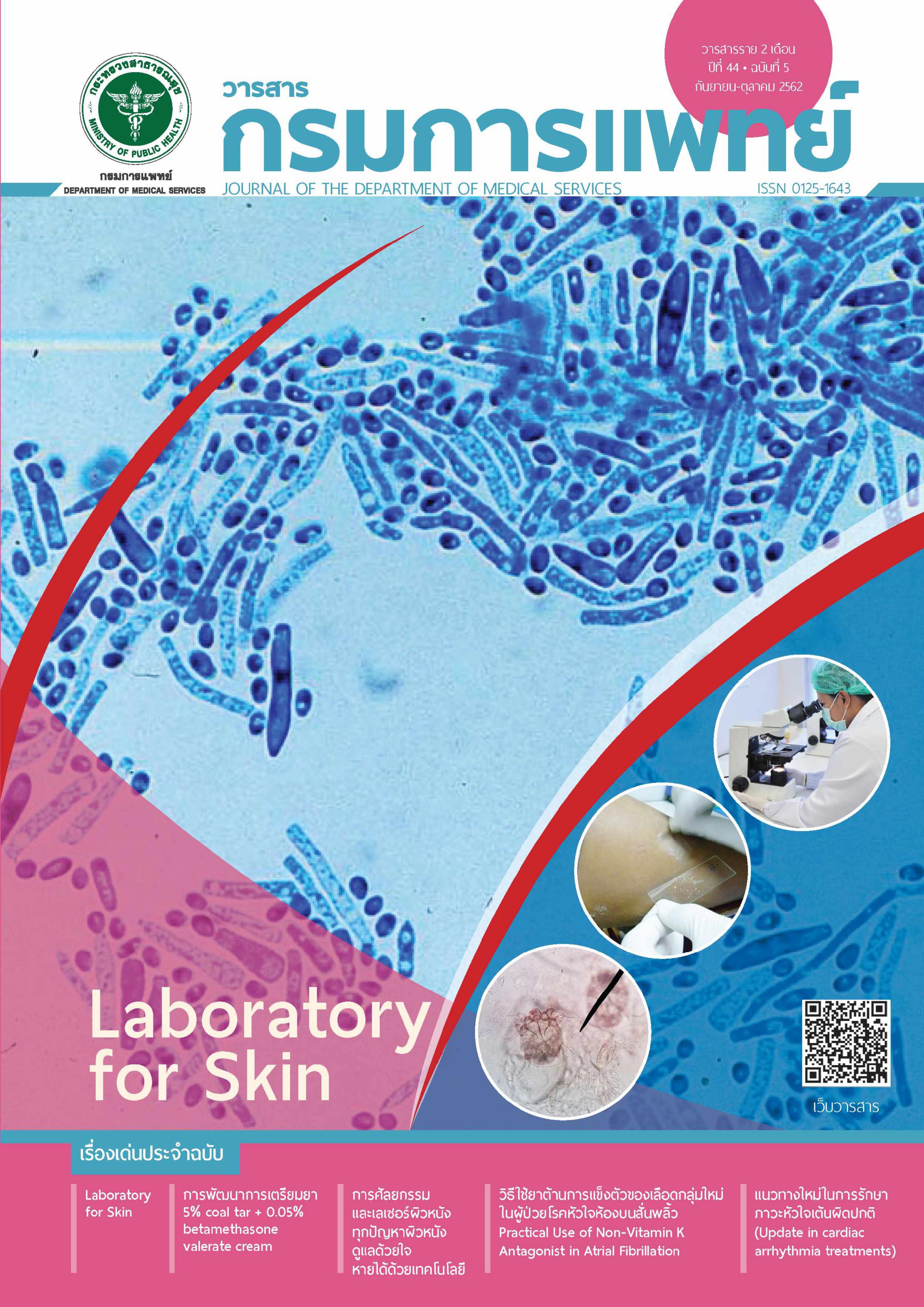Optimal INR Level in Patients Receiving the Triple Therapy
Keywords:
Dual antiplatelets, Triple therapy, Warfarin, Stroke, Bleeding, Atrial fibrillarionAbstract
Background: There are many patients receiving both dual antiplatelets and warfarin who are at risk of bleeding complication. However, no study on the optimal INR level in patients receiving triple therapy has been reported.
Objectives: To identify optimal INR level in Thai patients receiving triple therapy that caused the lowest thromboembolic and bleeding events.
Methods: Triple therapy patients were retrospectively enrolled since 1st January 2002 to 31st March 2013. The INR range were divided into 5 groups (less than 1.5, 1.5 to 2.0, 2.1 to 2.5, 2.6 to 3.0 and more than 3.0). Thromboembolicand bleeding events in each group were collected. The optimal INR level was the level that patients had the least thromboembolic and bleeding events. Results: A total of 235 patients (the mean age 61.3±10.9 years) were eligible, contributing to 122.35 patient-years of observational period. The patient-time spent within therapeutic INR range (2-3), less than 2 and more than 3 was 28.2%, 76.3%, 5.5%, respectively. Of 235 patients, one patient experienced one ischemic stroke (0.82 per 100 patient-years), 3 patients experienced 3 major life-threatening bleeding events (2.45 per 100 patient-years), one patient experienced one major non life-theatening bleeding event (0.82 per 100 patient-years), and 31 patients experienced 42 minor bleeding events (34.33 per 100 patient-years). Each group of INR level was not statistically significant in thromboembolic event. Total bleeding events was found to be significantly increased in INR level more than 1.5 (p < 0.001, 95%CI CI = 2.35-44.01, RR = 8.22).
Conclusions: The INR level less than 1.5 had the least total bleeding events and comparable ischemic stroke compared with the INR level more than 1.5 in patients with triple therapy. Further larger prospective study should be conducted to confirm these results in the future.
References
Camm AJ, Kirchhof P, Lip GY, Schotten U, Savelieva I, Ernst S, et al. Guidelines for the management of atrial fibrillation: the Task Force for the Management of Atrial Fibrillation of the European Society of Cardiology (ESC). Eur Heart J 2010; 31:2369-429.
Gao F, Zhou YJ, Wang ZJ, Shen H, Liu XL, Nie B, et al. Comparison of different antithrombotic regimens for patients with atrial fibrillation undergoing drug-eluting stent implantation. Circ J 2010; 74:701-8.
Chun-ming Cheung, Tak-hong Tsoi, Chen-ya Huang. The Lowest Effective Intensity of Prophylactic Anticoagulation for Patients with Atrial Fibrillation. Cerebrovasc Dis 2005; 20:114–9.
You JHS, Chan FWH, Wong RSM, Cheng G. Is INR between 2.0 and 3.0 the optimal level for Chinese patients on warfarin therapy for moderate-intensity anticoagulation? Br J Clin Pharmacol 2005; 59:582-7.
Takenori Yamaguchi. Optimal Intensity of Warfarin Therapy for Secondary Prevention of Stroke in Patients with Nonvalvular Atrial Fibrillation: A Multicenter, Prospective, Randomized Trial. Stroke 2000; 31:817-21.
Methavigul K and Boonyapisit W. Optimal INR Level in Thai Atrial Fibrillation Patients Who Were Receiving Warfarin for Stroke Prevention in Thailand. J Med Assoc Thai 2014; 97:1274-80.
Elaine M. Hylek, Steven J. Skates, Mary A. Sheehan, and Daniel E. Singer. An Analysis of the Lowest Effective Intensity of Prophylactic Anticoagulation For Patients with Nonrheumatic Atrial Fibrillation. N Engl J Med 1996; 335:540-6.
Jeanette C. van Latum, Peter J. Koudstaal, Jan van Gijn, L. Jaap Kappelle, and Ale Algra. Optimal Oral Anticoagulant Therapy In Patients with Nonrheumatic Atrial Fibrillation And Recent Cerebral Ischemia. N Engl J Med 1995; 333:5-10.
Wallentin L, Becker RC, Budaj A, Cannon CP, Emanuelsson H, Held C et al. Ticagrelor versus clopidogrel in patients with acute coronary syndromes. N Engl J Med 2009; 361: 1045-57.
Rosendaal FR, Cannegieter SC, van der Meer FJM, Briët E. A Method to Determine the Optimal Intensity of Oral Anticoagulant Therapy. Thrombosis and Haemostasis 1993; 69:236-39.
Jeffrey L. Anderson, Cynthia D. Adams, Elliott M. Antman, Charles R. Bridges, Robert M. Califf, Donald E. Casey et al. 2012 ACCF/AHA Focused Update Incorporated Into the ACCF/AHA 2007 Guidelines for the Management of Patients With Unstable Angina/Non–ST-Elevation Myocardial Infarction. J Am Coll Cardiol 2013; 61: e179–347.
Kuanprasert S, Dettrairat S, Palacajornsuk P, Kunachiwa W, Phrommintikul A. Prevalence of CYP2C9 and VKORC1 mutation in patients with valvular heart disease in northern Thailand. J Med Assoc Thai 2009; 92:1597-1601.
You JJ, Singer DE, Howard PA, Lane DA, Eckman MH, Fang MC, et al. Antithrombotic Therapy for Atrial Fibrillation: Antithrombotic Therapy and Prevention of Thrombosis, 9th ed: American College of Chest Physicians Evidence-Based Clinical Practice Guidelines. Chest 2012; 141: e531S-e575S.
Downloads
Published
How to Cite
Issue
Section
License
บทความที่ได้รับการตีพิมพ์เป็นลิขสิทธิ์ของกรมการแพทย์ กระทรวงสาธารณสุข
ข้อความและข้อคิดเห็นต่างๆ เป็นของผู้เขียนบทความ ไม่ใช่ความเห็นของกองบรรณาธิการหรือของวารสารกรมการแพทย์


